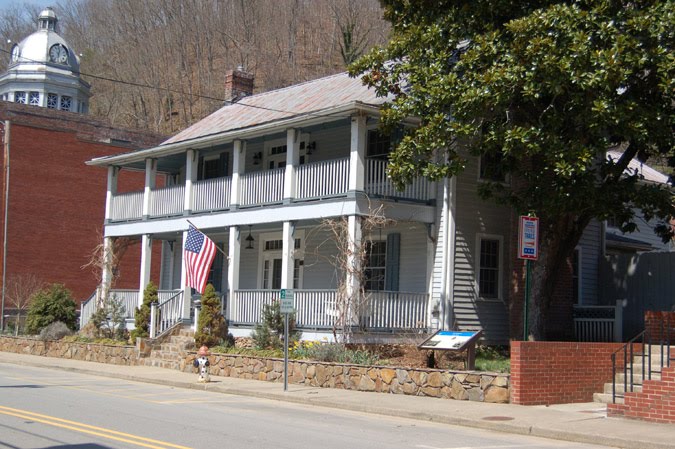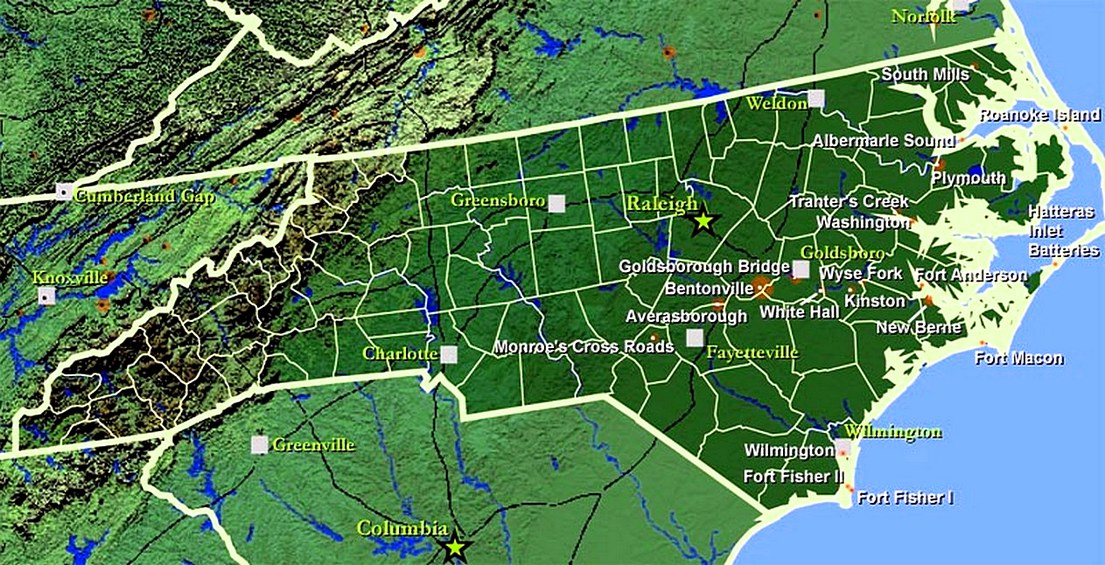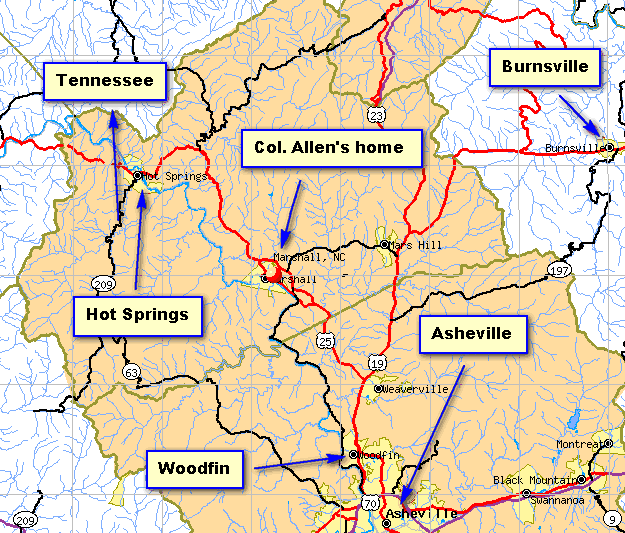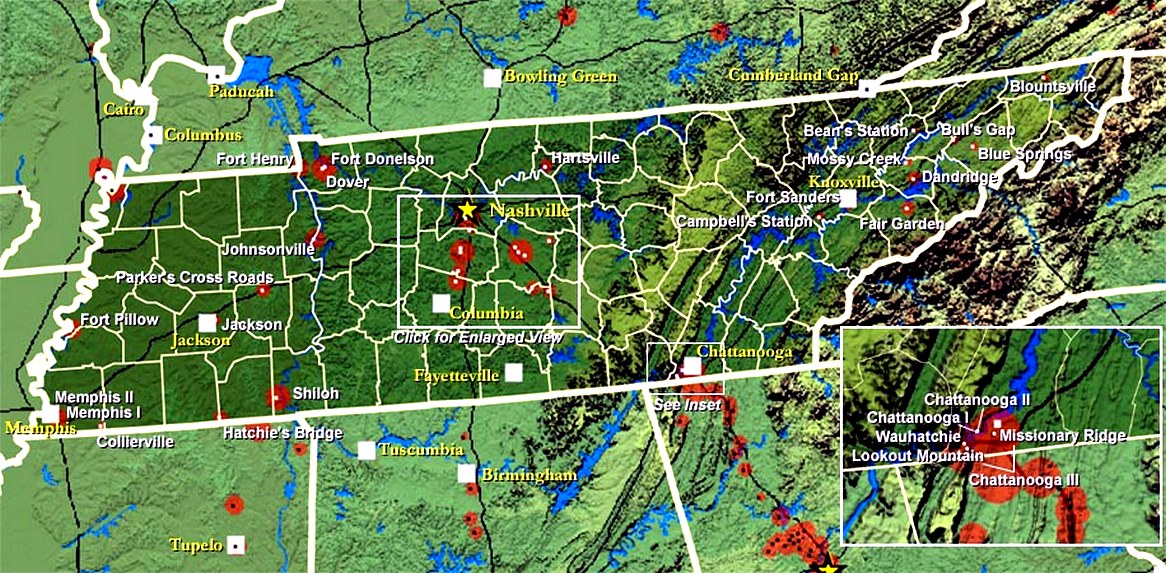|
COL. LAWRENCE M. ALLEN
COMMANDING THE 64TH REGIMENT, NORTH CAROLINA STATE TROOPS
DURING THE LATE CIVIL
WAR
By Capt. B.T. Morris (Ret.), 30 May, 1901
INTRODUCTION
The following is a brief sketch of Col. Lawrence
M. Allen’s campaigns in the mountains of East Tennessee and Western North Carolina while on detached service under military
orders. Only a few of the notable battles in which he was engaged are mentioned in this narrative, as such battles are recorded
in the regimental history.
The following true narrative, given according to
official reports, will show to some extent the extreme hardships and privations encountered in these disaffected parts of
the country, with the names of all the commissioned officers of the 64th
Regiment N.C. State Troops. (See 64th North Carolina Infantry Regiment: A Regimental History.)
FIELD AND STAFF,
OF THE SIXTY-FOURTH
N.C. REGIMENT C.S.A. IN 1862,
AS PER ROSTER AT RALEIGH, N.C.
Lawrence M. Allen, Colonel, Commissioned July 20th, 1862
J.A. Keith, Lieut.-Colonel, Commissioned Oct. 3d, 1862
W.N. Garrett, Major, Commissioned Oct. 3d, 1862
L.H. Smith, Adjutant
J.G. Hardy, Surgeon
J.G. Anderson, Assistant Surgeon
John B. Nelson, Assistant Quartermaster
W.B. Smith, Acting Commissary Sergeant
H.D. Waugh, Chaplain
Daniel Briscoe, Sergeant Major
J.C. Lowery, Quartermaster Sergeant
Edward Levan, Commissary Sergeant
J.G Rutlege, Commissary Sergeant
Robert Harper, Drum Major
J.M. Fulks, Musician
E.H. Merrimon, Quartermaster Sergeant
J.G. Rutlege, Ordnance Sergeant
THE YOUNG PATRIOT’S RESPONSE TO ARMS-HIS RAPID PROMOTION
| Home of Colonel Lawrence Allen, 64th NC |

|
| (Courtesy michaelchardy.blogspot.com) |
COL.
LAWRENCE M. ALLEN, the subject of this narrative, who became so conspicuous in the late Civil War as Colonel of the 64th N.C.
Volunteers, was born in Buncombe County, N.C., on the 15th of October, 1833. His father, Riley Allen, was a substantial farmer,
a kind father, and controlled well his household. Col. Allen's mother was a Miss Reese, from Spartanburg, S.C., before she
married Riley Allen, and on both sides of the house their ancestors were of Revolutionary extract. Lawrence M. Allen was an
energetic boy, always at the head of his class at school, strictly obedient, never giving his teachers trouble, and never
known to have any difficulty with his schoolmates or associates. He obtained a fair English education. In 1853 he married
a Miss Mary M. Peek, of excellent standing, and settled on a farm, and by industry, enterprise and integrity, acquired valuable
property in Marshall, N.C. About this
time a portion of Buncombe County, with a strip of Yancey, was cut off to form Madison County. Soon after this county was
organized, L.M. Allen was elected Clerk of the Superior Court of Madison County. He so well discharged the duty of his office
that in his second race his opponent, though in good standing, received only fifty votes in the whole county. L.M. Allen was
one of the leading Democrats of his county and always a delegate to the State Democratic Convention.
While Clerk of the Court, President Lincoln issued his
proclamation calling for troops to coerce South Carolina, as she had fired upon and captured Fort Sumter. This proclamation
created such a profound sensation that the militia were called out. On the Saturday following, a company of volunteers, one
hundred strong, were organized, and John Peek, a Mexican veteran, was made captain of the first company from Madison County.
At the first call Lawrence Allen volunteered, and installing
a deputy clerk in his office, he moved out with the company to Raleigh on the first of May, 1861. The company went into camp
of instruction, and shortly afterward, the 16th regiment, then called the 6th, was organized, and Captain Peek's Company was
lettered Company B in the regiment. Stephen D. Lee, of Asheville, was elected Colonel.
| Map of North Carolina Civil War Battlefields |

|
| High Resolution Map of Principal Battles Fought in North Carolina |
About the time of the battle of Big Bethel, the Regiment received marching
orders to go to West Virginia, at Valley Mountain, and was placed in Loring’s Brigade, Gen. R.E. Lee Commanding the
Department. About the first of July, 1861, another company of one hundred and twenty-five men was organized in Madison County,
and by a unanimous vote elected L.M. Allen their Captain, who received orders from the War Department to take charge of his
company and move without delay to Richmond, Va., which order was promptly obeyed. The company was placed with the 2d N.C.
Battalion, Col. Wharton J. Green commanding, which did duty in and around Richmond until December following.
| Colonel Lawrence Allen |

|
| Map of Col. Allen's Home in Marshall, NC |
The battalion was then ordered to Wilmington, N.C., as it was not known where
the Federal fleet, commanded by Gen. Burnside, would make an attack along the coast. They camped at Mitchell’s Sound
and drilled regularly until the 30th of January, 1862, when the battalion was ordered to proceed in haste to Roanoke Island.
The command hastened to Norfolk, Va., and was tugged, in barges on the Chesapeake Bay, to Roanoke. An engagement was going
on when it arrived, and landing amid the shells and shots of the enemy, the battalion formed and double-quicked three miles
to headquarters where it received orders. Col. Green did well his duty -- a brave officer and a true gentleman. Capt. Allen,
of Company A, did credit to himself and his command. The preparations for defence on the Island were poor and General Wise
being sick, had gone to Nag’s Head, and the command fell on Col. Shaw, of the 8th N.C. Volunteers, who did all in his
power to protect the Island, but the enemy was too formidable for the small force; so on the 8th of February, 1862, Col. Shaw
surrendered the Island to the Federal forces, commanded by Gen. Burnside. The third day afterward the Confederate officers
were marched under guard on to the steamer Spaulding, the field and staff getting cabin fare. All company officers were placed
in the hull of the vessel and well guarded. Within a few weeks they moved all the Confederate prisoners from the Island and
landed them at Elizabeth City, where they were all paroled, most of the 2d N.C. Battalion going up the Dismal Swamp Canal
to Norfolk, Virginia. Elizabeth City had been evacuated, and the soldiers suffered greatly for food. After a march of a couple
of days they got on tug boats and finally reached Norfolk.
Captain Allen and his company went by the Petersburg route
to Lynchburg, then took the East Tennessee and Virginia Railroad to Greenville, East Tennessee, the nearest point by rail
to their homes in Madison County, N.C. There were many slides in the road, which rendered their progress slow, but through
Virginia they were provided with rations.
Arriving at Greenville at 11 o’clock at night, Captain
Allen fed all his men, ninety-one in number, at a hotel, and moved out on foot at 9 A.M. The next day all reached their homes.
Soon after his arrival home Captain Allen received a summons to appear at Richmond, Virginia, before a Senate Committee to
give evidence relative to the battle and fall of Roanoke Island. Hon. B.S. Gaither, of North Carolina, was chairman of the
committee.
After the investigation Captain Allen visited many of
the North Carolina Regiments, then in front of Richmond, and after having an interview with the Secretary of War, returned
to his home at Marshall, N.C. After a little rest he used his influence in helping to organize troops. The first was a cavalry
company, one hundred strong. Captain Allen mounted and equipped the company out of his own funds, so by the 20th of July,
1862, he had 1,700 troops ready for action. By this time he was exchanged, commissioned Colonel, and received marching orders.
Allen’s Legion, for that it had been named, was
ordered to Greenville, East Tennessee, and drill officers assigned him, but in three weeks he was ordered with his command
to Knoxville to report to General E. Kirby Smith, commanding the Department of East Tennessee, and was at once assigned to
duty. Colonel Allen took great pride in military tactics and soon had his men well drilled. He was kind and good to his men,
but his orders had to be obeyed.
East Tennessee was so disaffected they had much hard service,
sending out scouting parties far and near. On the 30th of August, 1862, Colonel Allen was ordered to take four of his companies
and scour the mountains of Severe and Blount counties. They crossed Holston river at Knoxville after dark, traveled all night;
the next evening run on a body of men in the mountains, captured them, and found among them two who had recruiting papers
for the Federal service. Colonel Allen sent them under guard to Knoxville and continued his search, capturing quite a number
before his return, among them several recruiting officers. Colonel Allen, on his return to Knoxville,
was ordered with his legion into Kentucky, where he had several skirmishes with the Federal scouts. He joined the main army
just in time to be in the battle at Perryville, Kentucky, where, at the head of his column, he made a charge on the enemy’s
left wing, he being on the Confederate right. The Federals soon retreated, leaving him master of their former position. When
the Confederate army fell back into East Tennessee, Colonel Allen returned to Knoxville with several hundred government mules,
which had been captured while in Kentucky. He turned them over to the Chief Quartermaster, who sold them soon after at a government
sale.
| Map of Principal Battles Fought in Tennessee |

|
| High Resolution Map of Principal Battles Fought in Tennessee |
From 22d of October, 1862, until January 1, Colonel Allen commanded the post
at Knoxville, Tennessee. About 15th December, 1862, his legion was disbanded, his battalion of cavalry being assigned to that
of the gallant Colonel G.N. Folk, of North Carolina, making a full regiment. Colonel Allen commanded the Infantry, which was
constituted the 64th North Carolina Regiment Volunteers.
Early in January, 1863, Colonel Allen was ordered with
his regiment to Bristol to report to General Humphrey Marshall. Bristol is in both East Tennessee and Virginia. Being on the
line the enemy was raiding in from Kentucky, trying to destroy the salt works in southwest Virginia, which was so important
to the South for her supply of salt. The Colonel arrived in due time; the enemy was approaching in force, but were met and
repulsed with considerable loss. The coast being clear Colonel Allen returned to Knoxville, marching through several counties
in East Tennessee, capturing and breaking up several lawless bands....continue to 64th North Carolina Infantry Regiment: A Regimental History, by Captain B. T. Morris, Sixty-fourth North Carolina Regiment.
By Captain B. T. Morris, Sixty-fourth North Carolina Regiment
Source: Walter Clark, North Carolina
Regiments 1861-65, Volume III.
Recommended Reading: The Civil War in North Carolina.
Description: Numerous battles and skirmishes were fought in North Carolina during the Civil War, and the campaigns and battles themselves were crucial
in the grand strategy of the conflict and involved some of the most famous generals of the war. Continued below...
John Barrett presents the complete story of military engagements and battles across the state, including
the classical pitched battle of Bentonville--involving Generals Joe Johnston and William
Sherman--the siege of Fort Fisher, the amphibious campaigns on the
coast, and cavalry sweeps such as General George Stoneman's Raid. "Includes cavalry battles, Union Navy
operations, Confederate Navy expeditions, Naval bombardments, the land battles... [A]n indispensable edition." Also
available in hardcover: The Civil War in North Carolina.
Recommended Reading: Bushwhackers, The Civil War in North Carolina: The
Mountains (338 pages). Description: Trotter's book (which could have been titled "Murder, Mayhem, and Mountain Madness") is an epic backdrop
for the most horrific murdering, plundering and pillaging of the mountain communities of western North Carolina during the
state’s darkest hour—the American Civil War. Commonly referred to as Southern Appalachia, the North
Carolina and East Tennessee mountains witnessed divided loyalties in its bushwhackers
and guerrilla units. These so-called “bushwhackers” even used the conflict to settle old feuds and scores, which,
in some cases, continued well after the war ended. Continued below...
Some bushwhackers were highly organized ‘fighting
guerrilla units’ while others were a motley group of deserters and outliers, and, since most of them were residents
of the region, they were familiar with the terrain and made for a “very formidable foe.” In this work, Trotter
does a great job on covering the many facets of the bushwhackers, including their: battles, skirmishes, raids, activities,
motives, the outcome, and even the aftermath. This book is also a great source for tracing ancestors during the Civil War;
a must have for the family researcher of Southern Appalachia. "[T]he historical events that transpired in the region are brought to life in this
study."
Recommended
Reading: Remembering North Carolina's Confederates (NC) (Images of America). Description: The
American Civil War was scarcely over when a group of ladies met in Raleigh
and began to plan commemoration for the honored Confederate dead of North Carolina. In 1867, they held their first memorial service.
Two years later in Fayetteville,
the first monument to the state's fallen Confederate soldiers was erected. Over the next 14 decades, countless monuments were
commissioned in cemeteries and courthouse squares across the state. Continued below…
Following Reconstruction,
the veterans themselves began to gather in their local communities, and state and national reunions were held. For many of
the Confederate veterans, honor for their previous service continued long after their deaths: accounts of their sacrifice
were often chiseled on their grave markers. The numerous images within this book, photographs of veterans and reunions, monuments,
and tombstones are but a sampling of the many ways that the old Confederate soldiers are commemorated across the Old North State.
About the Author: Historian and photographer Michael C. Hardy is truly one-of-a-kind; he has dedicated and sacrificed his
life preserving North Carolina’s
Civil War history and heritage. With unmatched zeal and enthusiasm, Michael travels thousands of miles annually, while crisscrossing
North Carolina, teaching, educating, speaking, listening,
researching, and reading every conceivable aspect of the Civil War as it relates to the Old North State.
Michael C. Hardy is the author of numerous books and articles about North Carolina's role during the Civil War. This is his second book
for Arcadia Publishing. A popular speaker for history associations, preservation groups, and museums, he lives with his wife,
Elizabeth, and son, Nathaniel, in the mountains of Western North Carolina.
Recommended Reading: War
at Every Door: Partisan Politics and Guerrilla Violence in East Tennessee, 1860-1869. Description: One of the most divided regions of
the Confederacy, East Tennessee was the site of fierce Unionist resistance to secession, Confederate rule, and the Southern
war effort. It was also the scene of unrelenting 'irregular,' or guerrilla, warfare between Union and Confederate supporters,
a conflict that permanently altered the region's political, economic, and social landscape. In this study, Noel Fisher examines
the military and political struggle for control of East Tennessee from the secession crisis through the early years of Reconstruction,
focusing particularly on the military and political significance of the region's irregular activity. Continued below...
Fisher portrays in grim detail the brutality and ruthlessness employed not only by
partisan bands but also by Confederate and Union troops under constant threat of guerrilla attack and government officials
frustrated by unstinting dissent. He demonstrates that, generally, guerrillas were neither the romantic, daring figures of
Civil War legend nor mere thieves and murderers, but rather were ordinary men and women who fought to live under a government
of their choice and to drive out those who did not share their views.
Recommended Reading: North Carolinians in
the Era of the Civil War and Reconstruction. Description: Although North Carolina was a "home front"
state rather than a battlefield state for most of the Civil War, it was heavily involved in the Confederate war effort and
experienced many conflicts as a result.North Carolinians were divided over the issue of secession, and changes in race and
gender relations brought new controversy. Blacks fought for freedom, women sought greater independence, and their aspirations
for change stimulated fierce resistance from more privileged groups. Republicans and Democrats fought over power during Reconstruction
and for decades thereafter disagreed over the meaning of the war and Reconstruction. Continued below...
With
contributions by well-known historians as well as talented younger scholars, this volume offers new insights into all the
key issues of the Civil War era that played out in pronounced ways in the Tar
Heel State. In nine fascinating essays composed specifically for this volume, contributors address themes such
as ambivalent whites, freed blacks, the political establishment, racial hopes and fears, postwar ideology, and North Carolina
women. These issues of the Civil War and Reconstruction eras were so powerful that they continue to agitate North Carolinians today.
|

